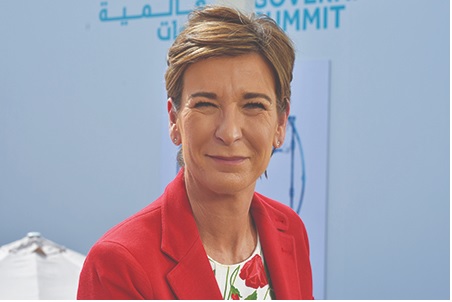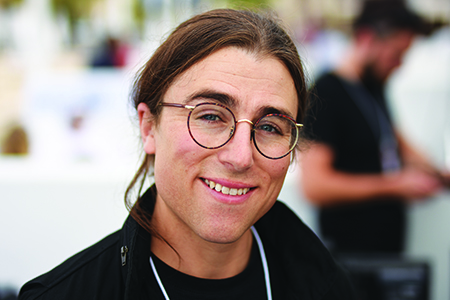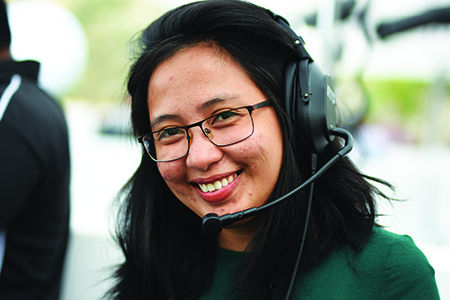During the historic visit of Pope Francis to the UAE, the country's leadership hosted a mass which brought together more than 180,000 people of different nationalities and faiths in Abu Dhabi. CNN was the only international broadcaster with the rights to broadcast the papal mass live. In a BroadcastPro ME exclusive, CNN's team members share their experience.

Becky Anderson, Anchor & Managing Editor, CNN Abu Dhabi
CNN Abu Dhabi has covered so many special events in the UAE, including the recent Special Olympics, and this has given us a wealth of knowledge and experience that can be brought to bear on events like the Pope’s visit.
We started planning in earnest around four weeks beforehand, alongside our usual reporting on a busy news cycle. The day itself was first and foremost a logistical challenge. We staggered the arrival of our team, beginning at 10 pm the previous evening. We needed to be conscious of road closures and making sure everyone got there in time.
In some ways, anchoring a live event rather than a carefully produced hour of TV is easier. You can roll with it and react to things, so it is more spontaneous. There’s a framework, and we know what each guest can talk about and what other elements are at our disposal, so there’s always somewhere to go, whatever happens. You need the scope to be able to rip up the plan if something remarkable happens.
There was a wonderful moment that really stays with me: John Defterios was outside the stadium in the crowd. The Popemobile went past him, and he handed back to us just as it entered the stadium. I had a panel of four people on set, and we all turned as the stadium erupted. There were families who had been waiting since 2 am with little children, some of whom were falling asleep. The parents were shaking them awake to catch the moment. It was truly special.
Mohammed Al-Saiegh, Producer
As a producer, you’re essentially looking at a jigsaw puzzle. It’s engineering, technical operations, the venue, the people in the stadium, the anchor and reporter on the ground, and you’re the gel that brings them all together, and to some extent absorbs the outside forces that will try to pull them apart.
You need to look at the whole operation layer by layer, thinking about how everything will work technically, how we want it to look and to flow editorially. Where will our guests be? What events are happening, and when? How will we best explain what’s going on to an audience in more than 200 countries around the world? How do we make that compelling?
I was very conscious that we were watching history in the making. It was a seminal moment, but it’s a little like the tree falling in the forest, if people around the world can’t witness it, then it is perhaps less seminal. It was important for us to convey the spirit of what was going on – the joy, the energy, the spirit – to really let the field breathe in and manifest that all to the screen.
It’s at times like that when you’re really thinking of the audience watching around the world. It’s the ‘This is CNN’ moment; you’re bringing them into the event, saying: “This is your world, and it’s amazing.”

Loren Gruenberger, Field Engineer
Normally, the challenge as a field engineer in newsgathering is to deal with constantly changing schedules, locations and live shots. But for the Pope’s visit, because the location was set, we were able to put what was basically a full studio set-up in the field.
Technically, our systems tend to be much more robust than the typical set-up. We firmly believe in satellite uplinks for shows that require resilient point-to-point transmission. We use LiveU, but we don’t always rely on it, because it can fail on a high-profile show. That philosophy carries through to the way we switch our shows; we have very high-quality field switchers, vision mixers, audio consoles, and we use the Dante audio IP solution that allows us to route any signal that we want, anywhere in the production realm. We’ve now started to implement RTS Odin, which is also a Dante-based intercom system.
That’s another thing that makes CNN distinct: the engineering team likes to bring the studio to the location, so all of our intercom capabilities are right in front of the producer, the director, the prompter operator and the anchor. RTS Odin allows us to do that really robustly in the field. It’s as though we are literally sitting next to the control room in Atlanta.

Louie Maliksi, Field Engineer
For the satellite transmission, one of the biggest challenges was to work with all the nationalities involved in the wider set-up. We were working closely with a French contractor. They were incredibly helpful, but there were inevitably some misunderstandings due to language issues. Of course, this part of the world uses PAL, so we also had to bring our own converters to switch it to NTSC.
We were a little separated from the mass, but even so, there was an incredible atmosphere, with Indians, Filipinos, Arabs, various nationalities and all the local volunteers. When you saw the excitement, especially among the Arab media – the way they reacted when the pope first appeared – it was incredible.

Jude Oommen, Senior Technical Director-Editor
We found an elevated spot to fit our anchor, three guests and the control room. But on the day we arrived, there was a massive new area of scaffolding, draped in white, right in front of our position. The immediate challenge for us was lighting. We knew we would have many guests during our coverage wearing a traditional white dress, so against a white background that would be tough to light well. We needed to bring in more lights and position the guests carefully. With such a long shoot, the movement of the sun was also an issue. We even went to IKEA and bought a little parasol to give us extra shade as the sun’s position changed.

Jay Sheren Sumera, IT Engineer
My role starts with making sure our internet connection is fine and there is no loss on it, making sure CNN’s proprietary content hub, iNews, works, along with the printers and all the IT infrastructure. I was monitoring our RTS Odin comms – which is our means of talking to our HQ in Atlanta and the return feed – to make sure everything flowed smoothly. That system is cutting-edge and pretty much unique to CNN.
As a Christian, for me the Pope’s visit was something I had prayed to be involved in. I’m from the Philippines, and only moved here two and a half years ago. I really saw the diversity here and the mutual respect people of different religions have for each other, and it reaffirmed my observations about the UAE as a tolerant place.

John Defterios, Emerging Markets Editor
CNN was the only international broadcaster outside the stadium. The first thing that struck me as a journalist was that the incredible diversity of the crowd needed to be conveyed to the outside world, and the fact that, in many ways, it mirrored UAE society.
The other thing that struck me was that it was so peaceful. There were no ushers, with 135,000 people outside. Once security got them in, they were on their own. It made for a very colourful and touching scene.
There were so many touching stories in the crowd, and those small stories underlined the importance of the big stories we’d been covering around the visit. You could see how much the Pope’s meetings and the words of tolerance and coexistence meant to ordinary people, particularly Christians.
People told us they were struck by the fact we addressed the trickier questions with our guests – particularly the conflict in Yemen.
It is hard to overestimate the significance of the Pope’s visit. I covered the first Gulf War in 1990/91, and I would genuinely put this as perhaps the next most important moment in my time covering the region.











































































